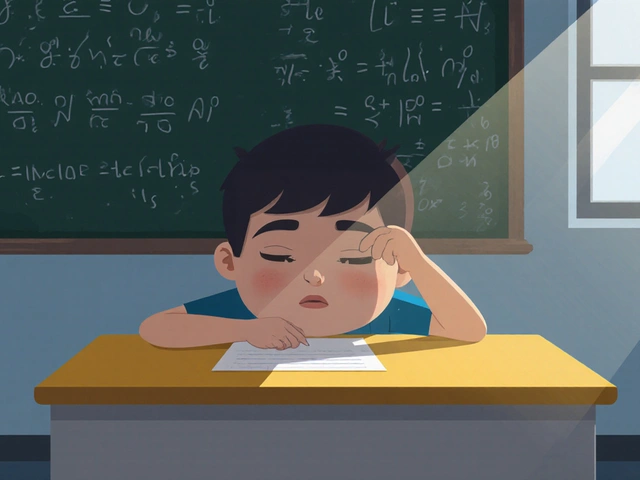
Every year, millions of Americans keep expired or unused medications in their medicine cabinets-old painkillers, leftover antibiotics, forgotten antidepressants. It’s easy to think, “I’ll just keep it in case I need it again.” But that’s not just a clutter problem. It’s a safety risk. Children find them. Teens misuse them. Water systems get contaminated. And the worst part? Most people don’t know how to get rid of them the right way.
Why Safe Disposal Matters
Keeping expired medications at home isn’t harmless. The CDC reports that around 60,000 emergency room visits each year are caused by accidental ingestion by kids under 6. The 2021 SAMHSA survey found that nearly 10 million Americans misused prescription drugs, and many got them from family medicine cabinets. Beyond personal risk, pharmaceuticals flushed down the toilet or tossed in the trash end up in rivers, lakes, and even drinking water. A 2002 USGS study found pharmaceutical residues in 80% of U.S. streams. That’s not theoretical-it’s happening right now.The goal isn’t perfection. It’s progress. The safest option is always a drug take-back program. But if you can’t get to one right away, you need a reliable, safe method to handle it yourself-without risking your family or the environment.
Best Option: Use a Drug Take-Back Program
If you can, use a drug take-back program. These are the gold standard. The DEA runs National Prescription Drug Take Back Day twice a year-last Saturday in April and October. In October 2022 alone, over 1 million pounds of medication were collected nationwide. That’s not a drop in the bucket-it’s a massive cleanup.You don’t have to wait for a special day, though. More than 14,000 permanent collection sites exist across the U.S., mostly at pharmacies like CVS and Walgreens. CVS has over 3,900 drop-off kiosks. Walgreens has nearly 1,500. These bins accept pills, patches, and liquids (but not sharps or inhalers). They’re free, secure, and the DEA destroys everything in high-temperature incinerators, neutralizing 99.8% of drugs.
Not sure where to go? Use the DEA’s online locator tool. Type in your zip code, and it shows nearby sites. Rural areas still lag behind cities-urban areas have over three times as many drop-off points. But the network is growing fast. Thanks to opioid settlement funds, more than $1.2 billion is being invested in disposal infrastructure through 2027.
What to Do When Take-Back Isn’t an Option
Sometimes, you can’t wait. Maybe you just found an old bottle in the back of the cabinet. Maybe you live far from a drop-off site. The FDA and EPA have a clear, science-backed method for home disposal. It’s not ideal-but it’s far better than flushing or tossing pills loose in the trash.Here’s how to do it right:
- Remove the medication from its original container. Don’t just dump the pills out. Take them out of the bottle. This prevents someone from finding your name, dosage, or prescription number later.
- Mix them with something unappealing. Use 1 cup (240ml) of used coffee grounds, cat litter, or dirt. This isn’t a suggestion-it’s a requirement. The goal is to make the mixture look and smell disgusting. A 1:1 ratio is key. Too little? Someone might dig through it. Too much? Waste of material. Used coffee grounds work best because they’re already in most homes and mask the smell.
- Put the mixture in a sealed container. Use a resealable plastic bag (at least 2-mil thick) or an empty margarine tub. Seal it tightly. This stops leaks and makes it harder for pets or kids to get into it.
- Hide your personal info. Take the prescription label off the bottle. Use a permanent marker to black out your name, the drug name, dosage, and pharmacy. Don’t just scribble over it-cover every inch. If you can’t remove the label, just mark over it completely. This step is skipped in nearly 30% of improper disposal cases, according to FDA reports.
- Throw it in the trash. Put the sealed container in your regular household trash. Do not put it in recycling. Medications are not recyclable.
This method reduces the risk of misuse and environmental harm. It doesn’t eliminate it entirely-studies show 15-20% of certain drugs can still be detected in landfill leachate-but it’s the best you can do at home.

Special Cases: Liquids, Inhalers, Needles, and More
Not all medications are the same. Some need extra care.Liquid medications: Pour them into a sealable container with coffee grounds or cat litter. Stir well. Seal. Trash. Never pour liquids down the sink or toilet.
Inhalers: These are pressurized. If crushed in a trash compactor, they can explode. Do not throw them in the trash. Take them to a medical waste facility or a pharmacy that accepts them. Some fire stations or hospitals also take them. Call ahead.
Needles and sharps: Never toss needles in the trash. Use an FDA-cleared sharps container. Most Walgreens locations give them out for free. If you can’t get one, use a rigid plastic bottle-like a detergent bottle-with walls at least 1mm thick. Seal it with heavy-duty tape. Label it “SHARPS-DO NOT RECYCLE.” Then take it to a designated collection site. Some pharmacies, hospitals, and health departments accept them.
Insulin and temperature-sensitive meds: Mix them immediately with absorbent material. Don’t let them sit in the bottle. Leaks can happen, and the medication can degrade. Use coffee grounds or cat litter right away.
What NOT to Do
There are dangerous myths out there. Don’t fall for them.- Don’t flush unless it’s on the FDA’s flush list. Only 15 medications are approved for flushing-mostly high-risk opioids like fentanyl patches and oxycodone. The full list is on the FDA’s website. Flushing anything else contributes to water pollution. The EPA says flushing accounts for 12% of pharmaceutical contamination in water.
- Don’t crush pills. Crushing releases dust and can expose you to the drug. Only use DisposeRx or similar products designed for crushing. Even then, follow the instructions exactly.
- Don’t recycle pill bottles. Even if the plastic is recyclable, the residue makes them unsafe for recycling plants. Reuse them for storage, or throw them in the trash after removing labels.
- Don’t just toss pills in the trash. Loose pills are easy for kids, pets, or scavengers to find. Always mix them with an unappealing substance.
Why Some People Still Get It Wrong
A 2022 Consumer Reports survey of 2,150 households found that 78% had tried to dispose of meds at home. But only 63% followed all the steps correctly. The most common mistakes? Not using enough coffee grounds or cat litter (37% of cases), forgetting to remove or cover personal info (29%), and using flimsy containers that leak (22%).People in rural areas face bigger hurdles. One Reddit user from Nebraska wrote: “I drive 47 miles to the nearest drop-off. I don’t have time. So I mix my pills with coffee grounds and throw them out. It’s not perfect, but it’s better than leaving them out.” That’s the reality for millions.
Experts agree: home disposal is a harm reduction tool, not a perfect solution. Dr. Theresa Michele from the FDA says, “The safest way to dispose of most types of unused or expired medicines is to immediately use a drug take-back option.” But she also acknowledges that not everyone can. That’s why the home method exists.

Make It Easier: Build a Disposal Kit
You don’t need to scramble when you find expired meds. Keep a simple disposal kit ready.Grab a small container. Put in:
- A small bag of used coffee grounds (dry, in a sealed ziplock)
- A roll of permanent marker
- A few resealable plastic bags (2-mil or thicker)
- A pair of scissors
Keep it near your medicine cabinet. When you find an expired pill, you can dispose of it in under 10 minutes. The National Association of Boards of Pharmacy found that people who use a pre-made kit make 64% fewer mistakes.
What’s Changing in 2025 and Beyond
Things are improving. The FDA updated its flush list in January 2023, removing two drugs and adding three based on new abuse data. A new mobile app for locating disposal sites is in beta testing-with 12,500 users already signed up. By 2025, new federal rules will require every prescription bottle to include disposal instructions on the label.By 2030, the Congressional Budget Office predicts 92% of U.S. households will have access to year-round disposal options. That’s up from 67% today. Environmental models predict a 35% drop in pharmaceutical contamination in water by 2040-if we keep building this infrastructure.
For now, your actions matter. Whether you use a drop-off bin or mix pills with coffee grounds, you’re helping. You’re protecting your kids. You’re keeping opioids off the streets. You’re keeping chemicals out of rivers. That’s not nothing.
Can I flush expired medications down the toilet?
Only if the medication is on the FDA’s official flush list. As of 2023, that includes only 15 drugs-mostly powerful opioids like fentanyl patches and oxycodone. Flushing anything else contributes to water pollution. The EPA estimates flushing accounts for 12% of pharmaceutical contamination in U.S. waterways. When in doubt, don’t flush. Use the coffee grounds method instead.
What if I don’t have coffee grounds or cat litter?
Use dirt, sand, or even used paper towels soaked in water. The goal is to make the mixture unappealing and hard to extract. Avoid using sugar, salt, or baking soda-they’re too easy to wash out. If you have nothing, mix the pills with water in a sealed bag and throw it in the trash. It’s not ideal, but it’s better than leaving pills loose.
Can I recycle empty pill bottles?
No. Even if the plastic is recyclable, residual medication makes them unsafe for recycling facilities. Most recycling centers reject them. Remove the label completely, then throw the bottle in the trash. You can reuse them for storing small items like screws or pills for travel-but never for food or drinks.
How do I dispose of insulin pens or needles?
Place used needles and insulin pens in a rigid, puncture-resistant container like a detergent bottle with 1mm-thick walls. Seal it with strong tape and label it “SHARPS.” Do not bend or break needles. Take the sealed container to a pharmacy, hospital, or local health department that accepts sharps. Many Walgreens and CVS locations offer free sharps containers and drop-off services.
Are there any free disposal services for people without cars?
Yes. Many pharmacies offer mail-back programs using prepaid envelopes like DisposeRx, which are often free with a prescription or available for $2.50-$5.00. Some local health departments and nonprofits run mobile collection events in underserved areas. Call your county health office or visit the DEA’s website to find options near you. In rural areas, mail-back is often the most practical solution.
Next Steps
Start today. Look in your medicine cabinet. Find one expired pill. Do one thing: remove it, mix it with coffee grounds, seal it, and throw it away. That’s one less risk in your home.Next week, check if there’s a take-back bin at your local pharmacy. If not, ask them to add one. Demand better access. The system is improving-but it needs more users to push it forward.
Safe disposal isn’t about being perfect. It’s about being responsible. And every pill you dispose of correctly is one less chance for harm.




mohit passi
November 26, 2025 AT 06:16Amanda Wong
November 27, 2025 AT 15:40JAY OKE
November 29, 2025 AT 04:23Joe bailey
November 30, 2025 AT 04:45Marissa Coratti
December 2, 2025 AT 04:28Micaela Yarman
December 3, 2025 AT 02:17Stephen Adeyanju
December 4, 2025 AT 20:22Ezequiel adrian
December 5, 2025 AT 19:46Ali Miller
December 7, 2025 AT 04:00Kaushik Das
December 7, 2025 AT 08:34Deborah Williams
December 7, 2025 AT 22:01james thomas
December 8, 2025 AT 01:23